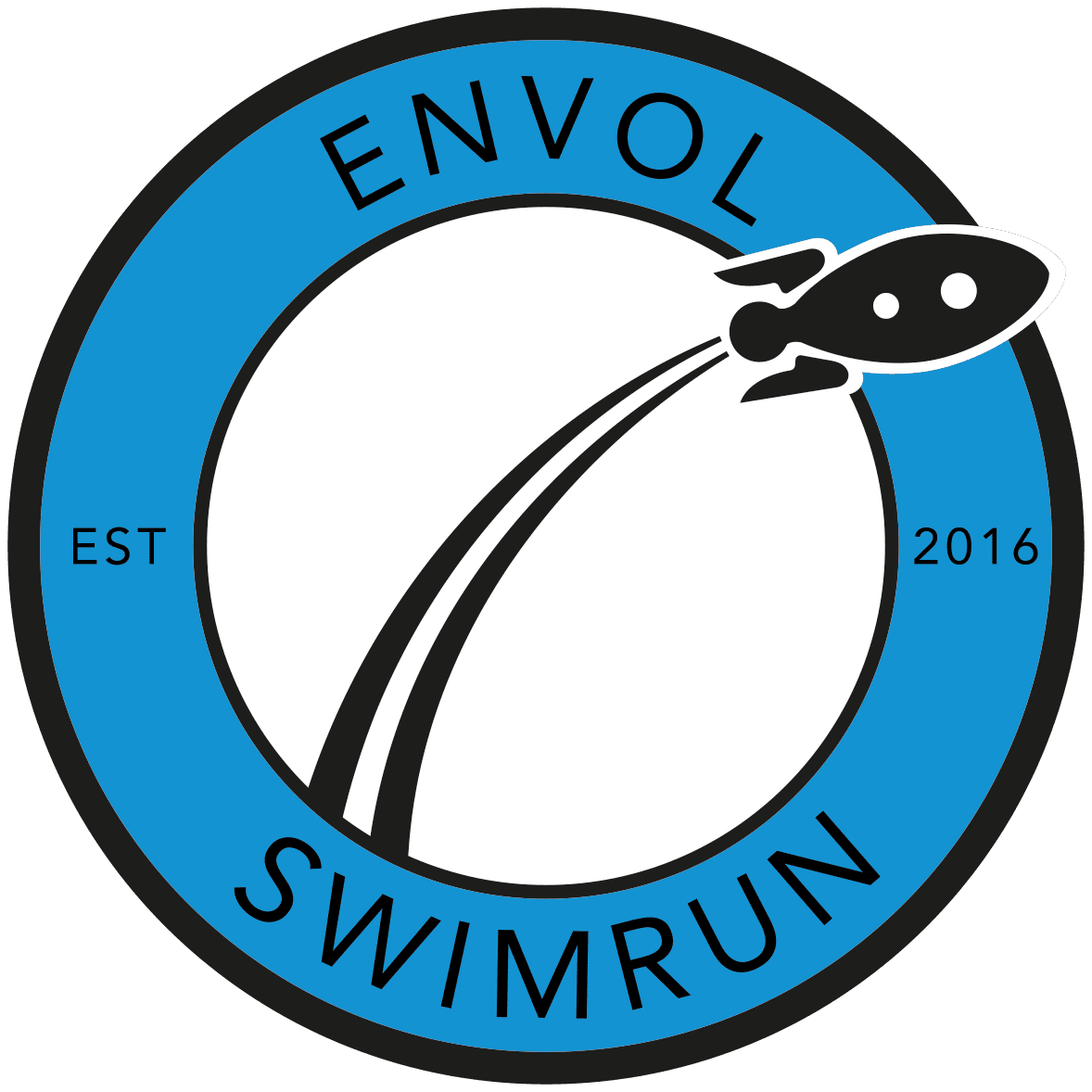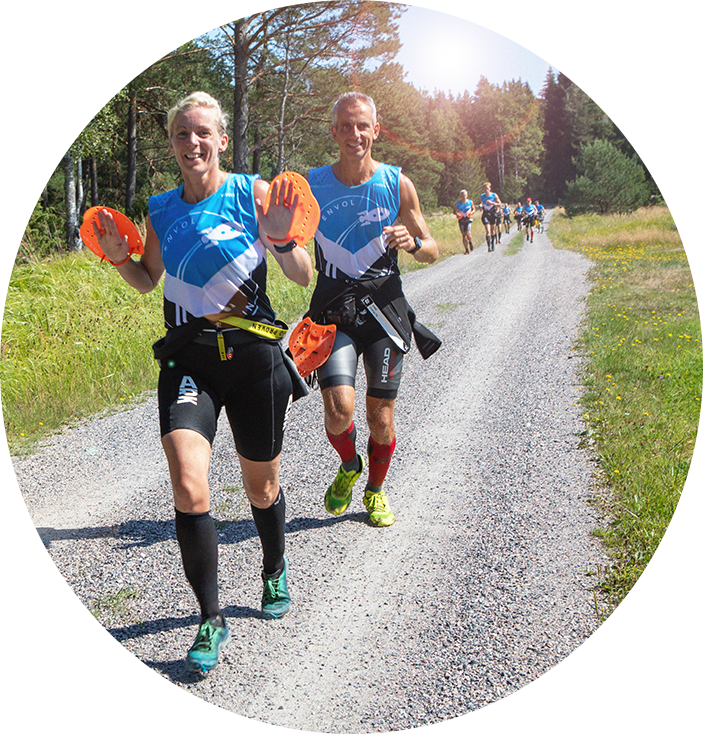Beginners guide to swimrun
Everything you need to know to get started!
But first, whatever gear you choose to swimrun with, make sure to practise as much as possible before that long adventure or race!
WETSUIT
There are many different brands and models out there. The thing is to find one that fits you and your purposes. The super thin, slick looking top of the range suit might look awesome, but if you think you need as much floatation as possible, or worry about the cold, it might not be for you.
Some brands are tighter around the legs, some around the shoulders. Do you want a zipper in the back or is it enough with one in the front?
If you want to run as free as possible, there are swimrun wetsuits with very thin fabric for the lower body, offering no more resistance than a running tight. Not much more buoyancy and warmth either. But with a good pull buoy the buoyancy will be taken care of anyway!
A good swimrun wetsuit is quite an investment and the second hand market should not be overlooked!
SHOES
Swimrun shoes should have thin, preferably mesh fabric not to hold too much water after swimming. Shoes with lots of padding and thick fabric are likely to get very heavy when wet. This is of course a problem for running but even while swimming heavy shoes will slow you down.
To have a good grip is important. Many races (and nature in general) will throw slippery rocks and technical trails in your path. If you only intend to swimrun in a reasonable urban landscape any pair of thin running shoes will do.
SOCKS
Socks should be thin (to not soak up too much water) and fit well on your foot. Loose wet socks are likely to become a problem. Some swimrunners like to wear long compression socks. Long socks are good if you want to put some extra floatation.
UNDERWEAR
Some do. Some don’t. If you do, choose something that fits well and doesn’t have big seams, to avoid chafing. For the ladies a sports bra can provide extra storage. Several brands have models with sewn in pockets.
SPECIAL SWIMRUN UNDERLAYERS
Several wetsuit brands that have specialised in swimrun also make specific layers to wear under. The main purpose here is storage and/or to stay warm.
PADDLES
If you look at a swimrun race most swimrunners use hand paddles. It’s simply a way to enforce your stroke. The key is to use paddles the right size. You need to be strong enough to use them right. It is advisable to start small and go up in size as you get more used to swimming with them and end strong enough to move more water! Too big paddles will only slow you down.
PULL BUOY
Good swimmers sometimes claim they don’t need a pull buoy. After trying swimming with their shoes, or simply trying swimming with a pull buoy they change their mind.
The pull buoy is used to make up for the drag of the shoes. It also makes kicking unnecessary, saving the legs for the running! If you feel like the pull buoy doesnt sit well between your legs, try another brand and/or size. If you are a 50 kg woman, using the same size and shape pull buoy as a 90 kg man, might not be a good idea.
TOWLINE
If you plan to race with it, you should train with it. It can also be nice to have during training just to “level out” the differences with your partner. Used in swimming, it makes the biggest difference but even in the run it’s possible to help a tired team mate quite a lot. Try it!
The rope should be elastic, but not too elastic. You want to avoid too much of a yo-yo effect. Lengthwise your partner should be close enough to ALMOST touch your feet while swimming.
GOGGLES
Some choose not to wear them for races in water that isn’t too salty. Most swimrunners do wear goggles and the best advice is to find a pair that fit your face. For race day it’s nice to have a fresh pair to avoid too much fog. When you run a tip is to turn them “inside out” (or wear them around your wrist), like that they are less likely to be all fogged up when you put them on for the next swim.
BELT/ROPE AROUND THE WAIST
Some wetsuits have a hook to attach the towline. If you don’t have this its a good idea to have a rope to hook on to for the towline. Some also like to hang their paddles and other gear on hooks in a belt. My advice is that less is more and if you can do without extra ropes and hooks it’s one less thing that can get tangled up and cause trouble.
WHERE TO STORE ENERGY
In the swimrun pockets, underlayer pockets, sports bra pocket … We advise against storing gels in the socks and inside underwear. There will be chafing. Soft bottles can be tucked in directly inside the wetsuit, just be aware that it can end up quite far from where you put it …
WHERE TO KEEP GEAR WHILE RUNNING
For shorter runs, swim caps and goggles can stay on your head (unless it’s very hot). Paddles can stay on your hands, you can loosen your fingers (to be able to use your hands) and just keep them attached at the wrist. For lunger runs it can be good to either stash them inside your wetsuit or hang them on your belt (if you don’t mind the dangling). Some do a full race without ever taking them off.
WHEN IT’S COLD
Long sleeves, neoprene swim cap or headband plus an underlayer. If you think you need it, wool underwear can be worn under the wetsuit. Just remember it is a bit of a hassle to take off if you find yourself too hot during a race. Taking enough energy is also crucial to avoid getting too cold. The body needs even more energy to keep the heating system going while operating in cold conditions.
WHEN IT’S HOT
Open up the wetsuit, take off the swim cap. If it is a longer run, take the time to pull the wetsuit completely down off your upper body. “Cab down”. Remember to drink and remember to get enough salt in. A lack of salt in the system could lead to cramps. Cramps hurt.
Individual online coaching
Envol Swimrun’s personal online coaching is perfect for those of you who have a specific goal, far away from your comfort zone or simply want to benefit from efficient coaching over a certain period of time. We will track your progress through regular communication and be there for you.
Suitable for athletes from all levels from beginner to advanced athletes. It would be the perfect preparation for a specific race but also to get into a good fitness.
Join Team Envol!
This is what you get:
- A community group where topics like races, training and advice are discussed
- Weekly online training plan on Training Peaks, adapted to your level and goals!
- Discount on Envol Swimrun products such as training camps or online coaching
- Help with finding a partner
- Best discounts/deals from our partners
- Discount on many race registrations
- Swimrun outings organised by Team Envol Ambassadors in your region
And so much more!


